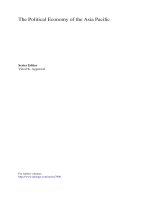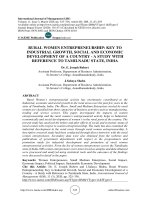Economic growth and economic development 13
Bạn đang xem bản rút gọn của tài liệu. Xem và tải ngay bản đầy đủ của tài liệu tại đây (42.64 KB, 1 trang )
Introduction to Modern Economic Growth
topics are important for creating a bridge between the empirical patterns we observe in practice and the theory. Most traditional growth models consider a single
economy in isolation and often after it has already embarked upon a process of
steady economic growth. A study of models that incorporate cross-country interdependences, structural change and the possibility of takeoffs will enable us to link
core topics of development economics, such as structural change, poverty traps or
the demographic transition, to the theory of economic growth.
Finally, Chapters 24-26 consider another topic often omitted from macroeconomics and economic growth textbooks; political economy. This is motivated by
the belief that the study of economic growth would be seriously hampered if we
failed to ask questions about the fundamental causes of why countries differ in
their economic performances. These questions invariably bring us to differences in
economic policies and institutions across nations. Political economy enables us to
develop models to understand why economic policies and institutions differ across
countries and must therefore be an integral part of the study of economic growth.
A few words on the philosophy and organization of the book might also be
useful for students and teachers. The underlying philosophy of the book is that all
the results that are stated should be proved or at least explained in detail. This
implies a somewhat different organization than existing books. Most textbooks in
economics do not provide proofs for many of the results that are stated or invoked,
and mathematical tools that are essential for the analysis are often taken for granted
or developed in appendices. In contrast, I have strived to provide simple proofs of
almost all results stated in this book. It turns out that once unnecessary generality
is removed, most results can be stated and proved in a way that is easily accessible
to graduate students. In fact, I believe that even somewhat long proofs are much
easier to understand than general statements made without proof, which leave the
reader wondering about why these statements are true.
I hope that the style I have chosen not only makes the book self-contained, but
also gives the students an opportunity to develop a thorough understanding of the
material. In addition, I present the basic mathematical tools necessary for analysis within the main body of the text. My own experience suggests that a “linear”
progression, where the necessary mathematical tools are introduced when needed,
makes it easier for the students to follow and appreciate the material. Consequently,
analysis of stability of dynamical systems, dynamic programming in discrete time
and optimal control in continuous time are all introduced within the main body of
the text. This should both help the students appreciate the foundations of the
theory of economic growth and also provide them with an introduction to the main
tools of dynamic economic analysis, which are increasingly used in every subdiscipline of economics. Throughout, when some material is technically more difficult
and can be skipped without loss of continuity, it is clearly marked with a “*”. The
xiii









